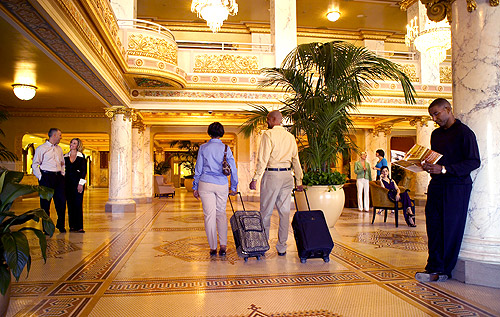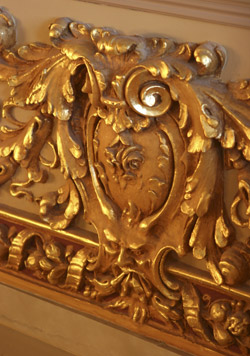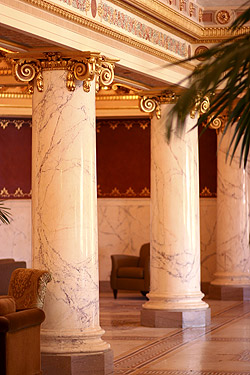
A Beaux Arts Treasure: French Lick Springs Hotel, French Lick, Ind
Restored by Conrad Schmitt Studios, a decorative painting and stained glass studios renowned for their work in historic and religious buildings. The addition of a casino and convention center to make the whole area a premier travel destination.
by Amy Johnson
to sum up the newly restored and renovated French Lick Springs Hotel in French Lick, Ind. It is the word used in the brochure that owners of the hotel, Blue Sky Casino LLC, created to detail the restoration of this century-old grand hotel — “The overall design is of the Beaux Arts architectural style, an eclectic Neoclassical style known for its use of ornate masonry work and grandiosity.”
That grandiosity has seen several ups and downs since the French Lick Springs Hotel and its famous sister, the West Baden Springs Hotel, originally opened as mineral springs health spas in the 1840s and 1850s. The first casino in the area was built in 1895. Then, the first wing of the building that is today’s French Lick Spring Hotel was opened in 1901, the same year the West Baden Springs Hotel burnt to the ground. The French Lick hotel and the rebuilt West Baden Springs continued to grow, attracting cure-seekers, golfers and gamblers until the Great Depression forced West Baden Springs to close and a 1949 police raid ended gambling in the area.
The French Lick Springs Hotel changed hands many times, never closing altogether, but steadily declining from its glorious apex. Then things began to turn around when the West Baden Springs property was purchased in 1996 by the Historic Landmarks Foundation of Indiana. The Foundation enlisted Bill and Gayle Cook, Indiana industrialists with a passion for historic preservation, who funded a $34 million stabilization and exterior renovation.
The return of legal gambling opened the way for a much larger project. The Cook Group purchased the French Lick Springs Resort (hotel and golf course) and entered into a joint venture, Blue Sky Casino LLC, with the Lauth Group Inc., to add a casino and convention center to make the whole area a premier travel destination. In late 2005 work began in earnest to completely restore the French Lick Springs Hotel, from its gilded Pluto Dome to its Scagliola columns.
Conrad Schmitt Studios, New Berlin, Wis., had been working with Bill and Gayle Cook and their son Carl on the West Baden Springs property, and they were up for the challenge when work began on the French Lick hotel. In business for nearly 120 years, the Conrad Schmitt Studios is one of the largest decorative painting and stained glass studios in the country, renowned for their work in historic and religious buildings.
The first thing a grand hotel needs is a grand entrance, so the entry and reception lobbies were at the top of the list for restoration. Damaged columns, wainscot panels and fireplace details had been repaired with plaster and painted over, and removing layers of paint yielded a discovery. These had originally been finished in Scagliola, plaster manipulated with silk fibers and pigment to replicate marble. “A restoration of this type is often ‘design/build’ as you go because you have to make adjustments and modifications when you come across something unexpected,” says Gunar Gruenke, vice president of Conrad Schmitt Studios. Restoring the Scagliola instead of simply repainting the columns was one of those adjustments, but Conrad Schmitt Studios was up to the task. Gruenke set up a shop in West Baden and rebuilt these pieces in Scagliola. “We did miles of it there,” he says.
 |
 |
As befits a Beaux Arts treasure, gold is the predominant color in the lobbies. The Studios repaired or replaced 850 plaster rosettes, then primed, gilded and glazed the rosettes for installation in the cornice of the coffered ceiling where each frames a round light bulb.
Gold was the motif for the Pluto Dome as well. This dome housed the mineral springs that attracted the earliest visitors to French Lick — and sales of “Pluto Water” sometimes surpassed other resort income in the early days. The original dome was gilded copper. Over the years the gold wore away and the dome fell into disrepair. To restore it to its golden splendor, Conrad Schmitt Studios primed the repaired dome with a two-part epoxy primer. Next they applied a slow-curing, oil-based size made specifically for adhering gold leaf. When the size reached the appropriate tackiness, they applied a ton of gold leaf and burnished it. They used palladium to gild the urns, scrolls and leaf swags for true grandiosity. Inside the dome, a fine restaurant sits under a palladium ceiling stenciled with lacy tans and cream. The elegant ivory palette lets stained glass windows take center stage, balanced by cartouches of fruit lacquered in red and green. Columns were faux-finished to evoke white Carrera marble.
As the name suggests, columns are the dominant feature of the Colonnade, a grand ballroom in 1925 and now a grand buffet. The Studios applied a faux marble finish to the famous columns and balanced the room with deep blue walls and gold, tans, and ambers. The original Colonnade showcased stenciled canvas above the windows and the pediments over the doors. After obtaining approval of on-site samples, Conrad Schmitt Studios removed the old canvas and shipped it back to the studio. They measured the windows, mapped the room and made a stencil plan. Using stencils made of mylar stencil paper, they reproduced the canvases at the studio, accenting the stenciled design by painting highlights and shadows freehand, just as the original artisans did. In the end they produced 7,000 linear feet of stencils in 13 different designs using 22 colors.
The Colonnade’s ceiling got special treatment too. Incompatible materials used in previous face-lifts posed a risk of flaking — undesirable anywhere, but especially over an eating area. The Studios patched cracks and smoothed the ceiling. They applied a polymer, let a 22-mil sheet of fiberglass soak into the polymer and then added another coat. This acts as a vapor barrier and prevents peeling. The whole thing was finished with a high-build paint.
Conrad Schmitt Studios’ expert staff of 65 artisans, consisting of conservators, muralists, plaster and Scagliola experts, were all called upon during the 50,000 man-hours put into the two successful hotel projects.
The restoration and preservation paid off and the Cook family continued their work, skillfully combining profit with philanthropy. Not only did they restore the French Lick and West Baden Springs hotels, they turned the Resort and Casino into a profitable enterprise and now are putting nearly half those profits back into funding grants for restoration education. In June 2007, Bill and Gayle Cook and their son Carl were honored by the Historic Landmarks Foundation of Indiana at the black-tie opening of the West Baden Springs Hotel.

|

